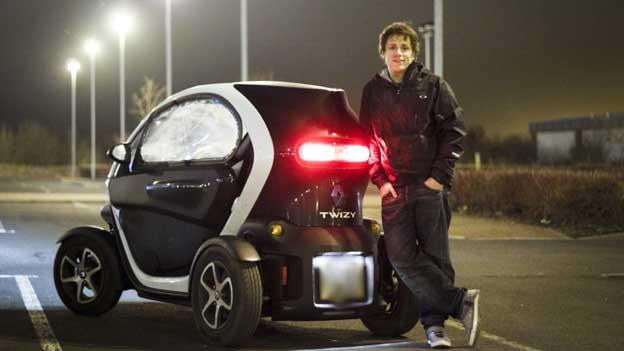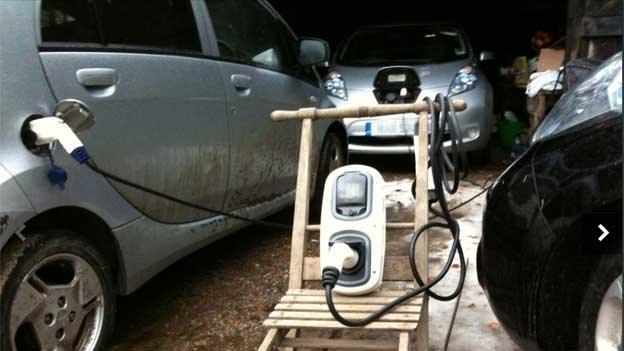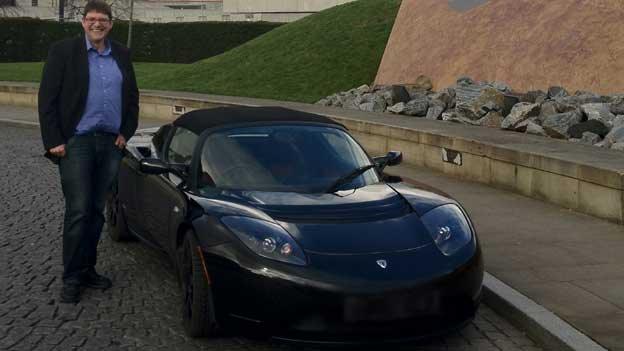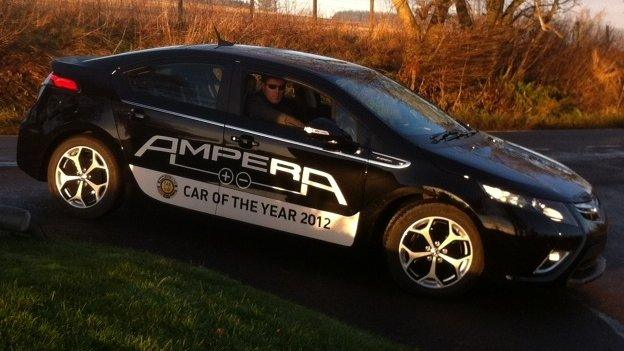Who drives electric cars?
- Published

Electric cars may be the future but problems such as "range anxiety" and the high purchase price are keeping them from becoming a more prominent feature on Scotland's roads.
Owners talk of the cars being fun to drive and being much cheaper to run than petrol or diesel. They can also be more environmentally friendly if the power they use is generated by renewable energy.
However, anyone living in a flat, or even a terraced house without a drive, could find them impractical to charge. And once fully-charged pure electric vehicles are usually not practical for long journeys, as there are very few fast-charge points.
So, who drives electric cars and what do they think?
Charlie Fraser drives a Renault Twizy

Charlie wants to be a racing car driver but for now he has to be more practical in his choice of vehicle.
The 21-year-old from Paisley drives the Renault Twizy, a two-seat electric vehicle.
He says: "I think it is the future and it was a much cheaper option than anything else."
Charlie says he gets a range of 35 to 40 miles from a full-charge but he is lucky to be able to power-up the car for free at Braehead shopping centre, where he works.
He says it takes about three-and-a-half hours to charge so it is usually topped up by the end of the day.
The Twizy is very much the compact end of the electric car market.
It is a two-seater, but Charlie explains: "If you have got a passenger in it does not really have room to store anything."
At almost £7,000, it is not exactly cheap but Charlie reckons it works out better value than getting the bus or the train.
And he says it is fun to drive.
"People don't think much of it at first but once they have been in it, it changes their mind.
"For around town you can squeeze through places and get places other people can't.
"From 20 to 30 mph it is really quite nippy. When you are pulling off, because it is silent, the first thing you notice is the movement not the noise of the engine. You just move."
Callum Burnett drives a Mitsubishi i-MiEV and a Nissan Leaf

Callum Burnett and his family have three electric vehicles, which they charge at his farm near Insch in Aberdeenshire.
Callum, 65, and his son Robert, 30, run Nissan Leafs and they also have a Mitsubishi i-MiEV.
"The iMiEV was bought as a second car," Callum says.
"We were short of a car for my wife to drive to work and back and wanted something really small.
"We found we could buy it through the business and there was a tax advantage.
"She uses it for a 30-odd mile commute backwards and forwards to work."
He says they soon found they were not using their diesel car at all.
"It was sitting for months on end. Everyone would just prefer to use the i-MiEV."
So he bought another electric car, the Nissan Leaf, which is larger than the i-MiEV and has a longer range.
Callum says the range which the cars can travel varies according to the conditions and the way they are driven.
Of the Leaf, Callum says: "You can get 80-odd miles if you drive it carefully. If you drive it hard, just like a petrol car, you can halve the consumption quite easily."
Callum's son Robert works at Aberdeen harbour and does a 30-mile drive into work and the same back in his Nissan Leaf.
Robert's work has installed a plug-in point so he can charge it and this gives him extra range if he wants to use it in the evenings.
However, Callum says that the current infrastructure for charging means that his son would not attempt a long journey.
Andrew Bissell drives a Tesla roadster

It is a pure electric car but it is also a high-performance sports car and has a price tag to match.
Andrew says: "It's an electric sports car which was made in Norfolk on the Lotus production line, the same production line which makes the Lotus elite.
"The car is designed by Tesla in California but actually it was made in Britain and it's got about a 200-mile useable range every day between charges and it does 0 to 60 in under four seconds. So it is a fairly quick car."
Electric cars tend to have good acceleration because all the power goes to driving the car but this one is extremely fast.
Andrew says it is a fun car to drive but he also had wanted the extra range that the 53kWh battery could provide.
He says: "I wanted to be able to go far because I wanted to be able to do everything I normally do.
"If someone says they want a meeting with me in Aberdeen or Perth, Glasgow or Newcastle, from my base near Edinburgh, I want to be able to jump in the car and go."
He adds: "I could have solved the problem by buying a plug-in hybrid like the Vauxhall Ampera but they weren't available three years ago when I bought this. At the time it was the only choice."
The cost of the car might be high but the costs of running it are nowhere near as much as an equivalent petrol sports car.
Instead of something in the region 20p per mile for a petrol car Andrew says he uses off-peak electricity at a rate of 7.5p per kWh.
At 3 miles per kw/h that is a cost of roughly 2.5p per mile.
Electricity pricing rates vary enormously as does the amount of power used per mile but it would be difficult for electric cars to currently work out more expensive on the price of fuel alone.
Andrew says he bought the car because he was excited by the technology but admits it is not a "completely rational choice".
John Mckenzie drives a Vauxhall Ampera

"It is not a hybrid," says John Mckenzie, a 38-year-old helicopter pilot who owns a farm near Dingwall in Ross-shire.
The Ampera is an Extended Range Electric Vehicle (E-Rev). The selling point of the E-rev is that is cuts out "range anxiety" because if the electric charge in the battery runs low the car can use petrol to generate more.
John says: "Petrol never drives the wheels. It is always electric that drives the wheels.
"The petrol drives the generator which makes electricity which turns the electric motors."
John says his regular commute to Inverness airport can be done purely on battery power.
However, he often flies from Cumbernauld airport and Edinburgh and this distance would not be possible in most electric cars.
With the Ampera he can drive 50 miles and then switch to petrol.
John adds: "I have driven the Nissan Leaf and the G-Wiz but I couldn't purchase one of these cars knowing that I would be constantly looking at how many miles to go and knowing I could miss a flight because I had run out of electricity."
He says even when they put in charging points along the A9 he would have to stop and wait for too long to make the journey practical.
John says he wants to be environmentally friendly and is generating his own renewable energy from solar, wind and hydro schemes on his farm but there also has to be an economic consideration.
"I am very passionate about Scotland and the environment but at the same time I can't put myself on the breadline by being silly and having a car that runs out of fuel or stretching myself."
He bought the car through his business and the high price of the Ampera - more than £32,000 after the £5,000 government grant - is partially offset by it being 100% tax deductible and having zero road tax.
John says the technology is getting better and batteries are lasting longer.
"It is like mobile phones," he says.
"They used to weigh 2kg and now look, technology moves fast. Somebody will probably come up with a battery the size of a few Duracells and it will power the car for hours on end."
- Published6 February 2013
- Published22 October 2012
- Published16 October 2012
- Published5 October 2012
- Published27 September 2012
- Published20 September 2012
- Published27 July 2012